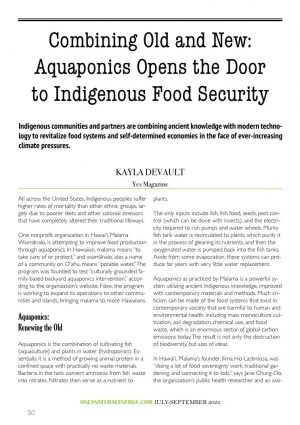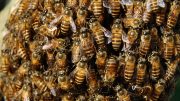 All across the United States, Indigenous peoples suffer higher rates of mortality than other ethnic groups, largely due to poorer diets and other colonial stressors that have completely altered their traditional lifeways.
All across the United States, Indigenous peoples suffer higher rates of mortality than other ethnic groups, largely due to poorer diets and other colonial stressors that have completely altered their traditional lifeways.
One nonprofit organization in Hawai‘i, Malama Waimānalo, is attempting to improve food production through aquaponics. In Hawaiian, malama means “to take care of or protect,” and waimānalo, also a name of a community on O‘ahu, means “potable water.” The program was founded to test “culturally grounded family-based backyard aquaponics intervention,” according to the organization’s website. Now, the program is working to expand its operations to other communities and islands, bringing malama to more Hawaiians.
Aquaponics: Renewing the Old
Aquaponics is the combination of cultivating fish (aquaculture) and plants in water (hydroponics). Essentially, it is a method of growing animal protein in a confined space with practically no waste materials. Bacteria in the tank convert ammonia from fish waste into nitrates. Nitrates then serve as a nutrient to plants.
The only inputs include fish, fish food, seeds, pest control (which can be done with insects), and the electricity required to run pumps and water wheels. Murky fish tank water is recirculated to plants, which purify it in the process of gleaning its nutrients, and then the oxygenated water is pumped back into the fish tanks. Aside from some evaporation, these systems can produce for years with very little water replacement.
Aquaponics as practiced by Malama is a powerful system utilizing ancient Indigenous knowledge, improved with contemporary materials and methods. Much criticism can be made of the food systems that exist in contemporary society that are harmful to human and environmental health, including mass monoculture cultivation, soil degradation, chemical use, and food waste, which is an enormous sector of global carbon emissions today. The result is not only the destruction of biodiversity, but also of ideas.
In Hawai‘i, Malama’s founder, Ilima Ho-Lastimosa, was “doing a lot of food sovereignty work, traditional gardening, and connecting it to kids,” says Jane Chung-Do, the organization’s public health researcher and an assistant professor of public health at the University of Hawai‘i at Hilo. Ho-Lastimosa’s vision was to preserve Native Hawaiian culture, founding a nonprofit in 2005 called God’s Country Waimanalo. The vision would grow into one that focused on ecological practices and the health benefits of returning to traditional diets.
Malama Waimānalo, as the organization was renamed, incorporated that cultural legacy into a program focused on backyard aquaponics. Ho-Lastimosa “just really saw the need for Hawaiian families to get interested in family-based, multigenerational, culture-based activities,” Chung-Do says.
A Legacy of Exploitation
While Hawai‘i has fantastic conditions for scientific research—including the first observations of increasing atmospheric carbon dioxide levels on Mauna Loa that led to early warnings of global warming—the state has always been at the intersection of exploration and exploitation.
Hawaiians were first “discovered” by Captain James Cook in 1778, and the islands became the site of sugar cane plantations owned by haole (White) sugar barons, a situation that persists to the present day. Though widely recognized as a sovereign nation since at least the 1840s, Hawai‘i suffered the cruel overthrowing of its queen and an abolishment of its language for nearly a century. The subsequent adoption into the United States in 1898 as a territory and in 1959 as a state has yet to provide sovereign rights to Native Hawaiians, as the U.S. does to people who are Indigenous to the contiguous United States and Alaska.
Today, the islands face high food costs and environmental destruction from the tourist industry. Couple these colonial stressors in Hawai‘i with a rapidly changing climate, and the topic of food sovereignty reigns superior.
Climate change, as evidenced by the rising carbon dioxide recordings in Mauna Loa (which have gone from 315 parts per million in 1958 to nearly 420 parts per million today) has caused the oceans around the Hawaiian Islands to warm, rise, and acidify. These changes have damaged coral reefs with algal blooms, harming other native food species that rely on reefs for calcium carbonate—the literal backbone of so many of these species. Consequently, land-based ecosystems are also suffering, as increased drought harms traditional foods like breadfruit and taro, which have fed Indigenous peoples on these islands since time immemorial.
In Waimānalo, on the eastern tip of O‘ahu, Malama’s backyard aquaponics research project is restoring sustainable and fresh foodways by rejuvenating harmonious techniques similar to the ancient ahupuaʻa method, which utilizes the water flowing from the mountains to the sea to grow plants and fish, Chung-Do says.
This traditional system divides land vertically along rivers so that each ahupuaʻa has a region of mountain, valley, and sea, creating a wedge of land with all a community’s needs along its slopes: salt, fish, taro, sweet potatoes, koa trees, and so forth. Although the classes the organization offers and the food-growing systems it implements are at a much smaller scale and use contemporary materials, Chung-Do says the team views these methods as “mini ahupuaʻa” capable of continuing traditional knowledge, foodways, and the healthy communities that come with it.
Chung-Do described the toll colonization, militarization, and mass agriculture took on Indigenous farming systems. Malama Waimānalo works to counter those effects by providing equipment and training to build backyard aquaponics systems and grow traditional plants, such as taro. She says the Waimānalo community has responded well to the concept and how it incorporates Indigenous ʻāina (“love of the land”) farming practices and stewardship.
The strength of aquaponics in this context comes from the symbiotic relationship of all the elements, Chung-Do says. All organisms involved (plants and fish and humans) benefit from each other, reflecting the relationship Indigenous peoples around the world have with the land. Malama, through its work, demonstrates that it’s possible to restore ancient methods and revitalize the systems threatened by modern environmentally damaging practices that do not contain the same symbiotic relationships, she says.
Restoring Traditional Foods in Untraditional Lands
While Hawai‘i faces its unique challenges as a collection of destination islands without a treaty that guarantees the rights of Native Hawaiians, other tribal communities within the geopolitical boundaries of the United States navigate their own troubled waters. They face many historically similar challenges, threats of cultural erasure, and legacies of oppression. While many tribes are combating the high prevalence of obesity, diabetes, and other diseases in their communities by restoring traditional foodways and place-based spirituality, tribes removed from their ancestral lands must find unique ways to cope.
The Seminole Nation of Oklahoma teamed up with Symbiotic Aquaponic, a Native-run company, to build customized aquaponics farming systems for individuals, schools, businesses, communities, and tribes. Kaben and Shelby Smallwood, two brothers from the neighboring Choctaw Nation of Oklahoma, founded the business in 2012. Symbiotic Aquaponic partnered with, trained, and provided equipment to the Seminole Nation through a grant, and now that system grows and distributes foods to the tribe. These systems allow organic foods to be grown with 1% of the water used in industrial agriculture, empowering Oklahoma tribes who, like the Seminole and Choctaw, were forcibly relocated here.
Seminole Aquaponics, a division of the Seminole Nation Division of Commerce in Oklahoma, is managed by rancher and self-described former-nurse-gone-ag Rebecca Votaw. Votaw, who is not Native, combines her passion for holistic healing with the Seminole traditions of her husband and children’s Indigenous ancestors to restore food sovereignty for the tribal nation and help improve its members’ health.
Votaw grows traditional foods in the system, such as the Three Sisters (corn, pole beans, and squash), and also prioritizes finding the best varieties for nutrition, seed saving, and succession planting. She also grows Job’s Tears, a variety of millet related to maize and other important crops, and analyzes seed catalogs to pick tomato varieties that can be canned if a surplus is produced.
“The whole idea for creating [an aquaponics system] was finding ways to expand on [Seminole] food sovereignty, but also create a business that could potentially turn around and affect the community,” Votaw explains. “If used properly, and the way it was intended for, it will do just that. But it’s a growth process.”
One of the initial barriers to that growth process was a financial one. Votaw says that startup costs are high, but the return on investment can be surprising. For example, Seminole Aquaponics started with 12 pounds of bluegill in one tank. In less than a year, that had increased to 29 pounds, and the tribe is now expanding its system to include catfish and bass.
All the project’s income goes back into expanding the system. Votaw says that, in early spring, they are “starting seeds, putting in pots, and getting ready for plant sales to make available to the [Seminole] Nation and outside sources.” Seeds are started on-site near the aquaponics system and then transferred to pots to make the best use of limited space. Besides distributing produce, these pots are also given to tribal members to grow their own food, create their own seed banks, and continue the positive feedback loop. Because potting soil is expensive, Votaw is now introducing red wiggler worms and their castings. She calls it “doing our own worms” to reduce costs and exponentially increase the system’s zero-waste quality.
One of the challenges for the Seminole Nation of Oklahoma, however, is that not all traditional foods thrive in the hot Oklahoma summers like they did in the tribe’s ancestral lands in the American Southeast, before the tribes were forcefully relocated in the 19th century. Examples include the medicinal tea leaf yaupon, the incense sweetgrass, and blueberries. Votaw says tribal members have tried different techniques to grow these species, such as companion planting, and continue to explore a variety of options for maximum nutrition and the benefits of an aquaponics system that is sheltered from the weather.
But she says the best part of their aquaponics endeavor is the flavor.
When visitors bite into ancient yellow and purple carrots, Votaw says, they are surprised by the taste. “People in general, that shocks them, because store-bought food is picked too early and is not the same flavor.”
Seminole Aquaponics also provides tribal youth with wholesome samples as part of its partnership with various diabetes and wellness programs. The food Votaw and her two-person team grows packs a punch of nutrients and taste to get tribal members tucking in.
Restoring Indigenous foodways is not just about restoring sovereignty and traditional practices. It’s also about celebrating the ancestors and taking care of a community of relatives. “Food is the center of so many Indigenous cultures. Food is central to everyone’s health,” Malama Waimānalo’s Chung-Do says. She says the participatory community endeavor is being validated by the impact aquaponics are having in Native Hawaiian households. Not only are families eating healthier, but children are learning where their food comes from, and entire communities are reconnecting to the land.
Abaki Beck contributed research to this story.
This story has been supported by the Solutions Journalism Network, a nonprofit organization dedicated to rigorous and compelling reporting about responses to social problems.
Kayla Devault
Originally published by
YES!Media
May 31, 2022





